In the corridors of Wall Street, whispers of an imminent approval for a spot Bitcoin ETF have reached a deafening crescendo.
As seasoned market participants know, there exists a time-honored Wall Street maxim: “Buy the rumor, sell the news.” This age-old adage is rooted in the idea that when investors eagerly anticipate an impending event and make their moves accordingly, by the time the event materializes, a curious shift occurs. The landscape becomes dotted not only with eager buyers but also with those who’ve already fired their cannons, now ready to offload their positions.
So, here we stand on the precipice of what seems to be the industry’s worst-kept secret – the impending launch of a slew of spot Bitcoin ETFs. As we edge closer to this momentous event, one must ponder: when the news does finally break, will it usher in a time to consider taking profits?
Before we venture into the realm of future possibilities, let’s cast a quick glance into the rearview mirror and revisit the past.
It’s worth noting that this adage has played out with almost uncanny precision in recent memory, particularly during the two most significant regulatory pronouncements in our blockchain realm.
Throughout the entirety of 2017, the markets were charged up with an electrifying mantra: “When the CME lists Bitcoin futures, we’re strapping ourselves in for a rocket ride TO THE MOON!”
And let me tell you, folks, the markets did indeed surge – a staggering 2,448%! That’s some bullish momentum you don’t see every day! But here’s where the story takes a twist, and it’s a twist that’ll leave you scratching your head.

The very day those futures finally hit the scene, that was it– that was the tippity-top, the pinnacle, the summit. It marked the beginning of an astonishing -84% bear market that sent shockwaves throughout the crypto world, right from day one. Incredible, isn’t it?
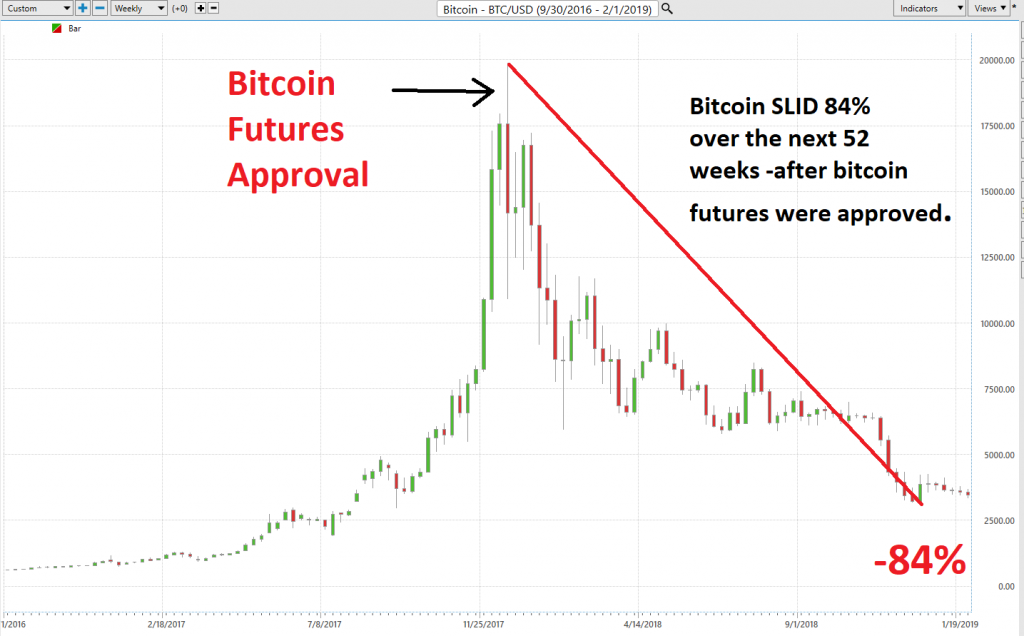
You won’t believe it, but history has a peculiar way of repeating itself in the wild world of markets and let me tell you about this one – it’s a real doozy!
Leading up to the public listing of Coinbase, the entire crypto universe was buzzing with excitement. The anticipation was palpable, and the industry was in full celebration mode, reveling in the imminent direct listing of Coinbase. This listing was proof that Cryptocurrency was going mainstream and no longer considered a fringe asset class.
Now, here’s where it gets intriguing. The Bitcoin market, on a tear, was up a staggering 848% as it approached the grand day of Coinbase’s listing. That’s not a small feat. But hold onto your seats because here’s the kicker – on the very day of Coinbase’s debut, Bitcoin hit a jaw-dropping peak at $64,863. That’s the stuff dreams are made of, right?
But, as fate would have it, right after that pinnacle moment, bitcoin stumbled a gut-wrenching 54% in the following weeks. It managed to rally and make new highs but eventually ushered in a -75% bear market. It’s like déjà vu, folks! The crypto market showing us once again that what goes up, well, it can come down mighty hard.
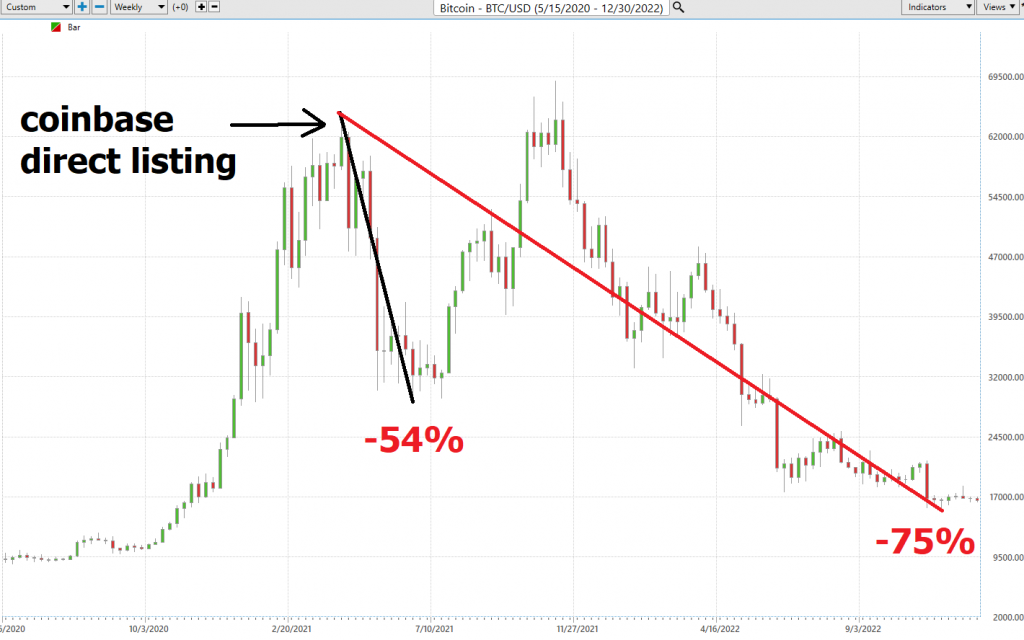
Several companies have applied to the U.S. Securities and Exchange Commission (SEC) for approval of a Bitcoin ETF. The quantity of applications as well as the total assets under management (AUM) of the applicants has the cryptocurrency community very excited.
The key applicants include:
1. **BlackRock**: Filed for a spot Bitcoin ETF on June 15, with Coinbase as the crypto custodian and BNY Mellon as its cash custodian. The SEC formally accepted BlackRock’s spot Bitcoin ETF application for review on July 15.
2. **WisdomTree**: Originally filed for a spot Bitcoin ETF in the U.S. on December 8, 2021, but faced rejection by the SEC in 2022. WisdomTree refiled with the SEC on July 19.
3. **Valkyrie Investments**: Filed its first spot Bitcoin ETF application in January 2021 but was rejected. Valkyrie refiled its application on June 21. The ETF would refer to the Chicago Mercantile Exchange’s (CME) reference price for Bitcoin and trade on NYSE Arca.
4. **ARK Invest**: Filed an application for its ARK 21Shares Bitcoin ETF in June 2021. ARK Invest has partnered with Swiss-based ETF provider 21Shares, planning to launch on the Chicago Board Options Exchange (Cboe) BZX Exchange under the ticker symbol ARKB if approved.
5. **VanEck**: One of the earliest Bitcoin ETF applicants, first filed in 2018. VanEck withdrew its application in September 2019 and made a second attempt with the SEC in December 2020. A new application was filed in July 2023.
6. **Fidelity/Wise Origin**: Fidelity Investments first applied for a spot Bitcoin ETF in 2021 and refiled for its Wise Origin Bitcoin Trust on July 19, 2023. Fidelity Service Company would serve as the administrator, and Fidelity Digital Assets would function as the BTC custodian.
7. **Invesco Galaxy Bitcoin ETF**: Invesco filed an application for its Invesco Galaxy Bitcoin ETF jointly with Galaxy Digital on September 22, 2021. They refiled their application in July 2023. The joint Bitcoin ETF would be physically backed by Bitcoin, with Invesco Capital Management as the sponsor.
8. **Bitwise**: Initially filed for a spot Bitcoin ETF in October 2021 but was rejected by the SEC. The asset manager refiled its application in August 2023.
9. **GlobalX**: Entered the ETF race in 2021 with a spot Bitcoin ETF filing. GlobalX refiled its application in August 2023, naming Coinbase as its surveillance-sharing partner.
These applications highlight the growing interest and efforts by major financial institutions to bring Bitcoin ETFs to the market, despite facing regulatory challenges and scrutiny from the SEC. The total AUM for these companies (excluding Valkyrie Investments and Bitwise for which precise AUM is not readily available) would be approximately $16 trillion. This figure is a ballpark estimate and should be treated with caution, as AUM can fluctuate significantly due to market conditions and other factors.
What money managers, traders and investors are all contemplating is the long-term consequences on Bitcoin’s price when simply 1% or 2% of AUM move into Bitcoin. Conservative estimates project that bitcoins price would rise to roughly $250,000 should this occur.
So, you can see a lot of enthusiasm is riding on the approval of a bitcoin ETF.
I received questions regularly asking me for my opinion on what will happen with Bitcoin. I always welcome those conversations, but I am completely indifferent because I use a regular dollar cost averaging program to buy my Bitcoin.
I discovered bitcoin in 2013 and for the first 3 years I was convinced it was the world’s biggest fraud. However, in 2016 I genuinely began studying bitcoin. It took me about 18 months to feel that I understood it well enough to talk with others about it. For the last 5 years, I buy bitcoin every week by committing an exceedingly small amount of my income towards saving in bitcoin.
Dollar-cost averaging (DCA) and lump-sum investing are two distinct strategies used by investors to manage their entry into the market. Dollar-cost averaging involves regularly investing a fixed amount of money over time, regardless of market conditions. This method allows investors to purchase more shares when prices are low and fewer when prices are high, potentially reducing the average cost per share over time. The primary benefit of DCA is that it mitigates the impact of market volatility on the investment, as the investment is spread out over time. This approach is particularly advantageous for risk-averse investors or those new to investing, as it reduces the psychological stress of market fluctuations and timing the market. However, the drawback of DCA is that it may result in lower returns compared to lump-sum investing during a rising market, as a portion of the capital remains uninvested for some time.
On the other hand, lump-sum investing involves investing a large amount of money at once. This strategy is based on the concept that markets tend to rise over the long term, and thus investing a large sum immediately can potentially lead to higher returns compared to spreading out the investment. Lump-sum investing is particularly effective in bullish market conditions where the early maximization of market exposure can lead to significant gains. The primary advantage of this approach is the potential for higher returns due to longer exposure to market growth. However, the main drawback is the risk of market timing – if a lump-sum investment is made just before a market downturn, the investor could see a significant initial loss. This strategy generally requires more market knowledge and risk tolerance, as it can lead to larger losses in a declining market.
DCA is a strategy that entails making consistent, fixed investments at regular intervals rather than making large or sporadic purchases. While cryptocurrencies, particularly Bitcoin, can be known for their wild price swings, applying DCA to crypto assets can help mitigate some of the risks and provide a structured approach to investing.
Let me explain and provide some immensely powerful real-world examples.
First off, let’s look at and analyze the 10-year chart of Bitcoin.
The very first thing you will come to understand is that this asset is incredibly volatile. Often times your entire perspective and opinion of an asset is determined only by where you committed your lump sum amount to acquiring it.
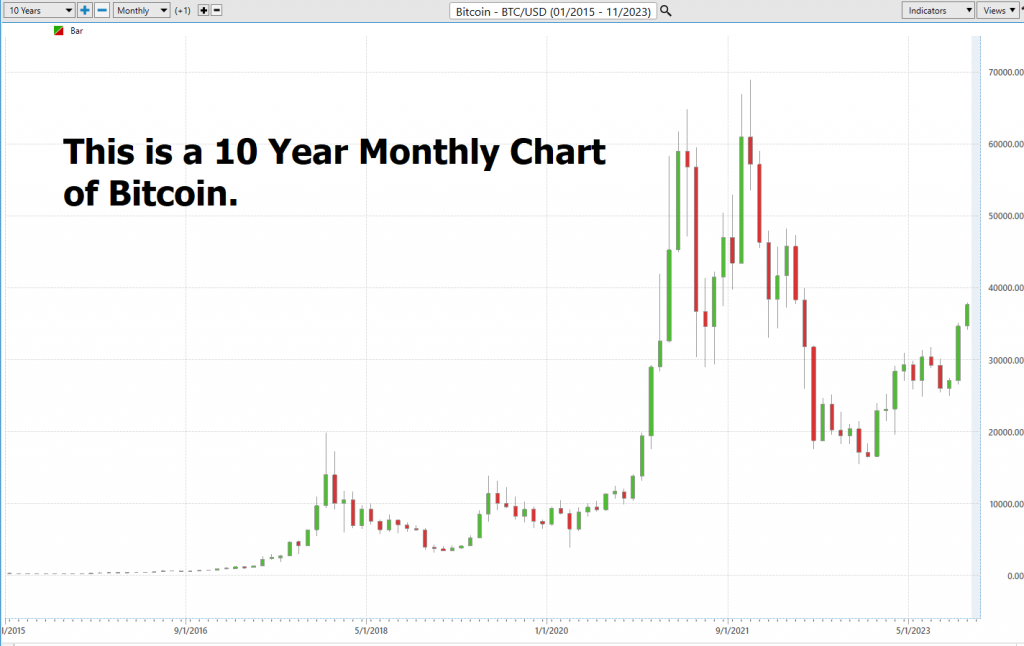
I will illustrate the nature of dollar cost averaging in bitcoin by providing some real-world examples of an investor who commits to a $100 per week investment over the last 5 years. For purposes of illustration and simplicity, we will assume that $100 of bitcoin is purchased every week at the closing price of the week and that this is continued for the entire 5 years.
Here are the results:
$100 of bitcoin purchased every Friday on the published Closing price of the week.
After 5 years $26,100 have been invested.
It has acquired 2.0147 bitcoin at an average price of $12,954.26 per bitcoin.
The highest price purchased $64,086.
The lowest price purchased was $3,231.
Based upon current market prices it is currently up 182%.
Despite bitcoins incredible volatility, you can see that a small regular commitment every week was a very viable and profitable way to preserve value and store wealth.
But in the hopes of shedding light on the power and effectiveness of dollar cost averaging bitcoin let’s look at our dollar cost averaging example a little differently. Let’s enter into a DCA starting with the HIGHEST price for bitcoin of $64,086 which occurred on 11/6/2021. A simple $100 weekly commitment would have resulted in the following results:
Invested $10,600 over the last 2 years.
Acquired .39818 bitcoin.
Average price was $26,621
Based upon current market prices this DCA would be up 33.6%! Keep in mind this is starting at the time of the COINBASE Direct Listing occurred and continuing throughout the entire last two years of bitcoin winter.
Here is a weekly chart of Bitcoin over the last 5 years to provide appropriate perspective and understanding. Would you find either of these scenarios acceptable? Trust me, when you are up BIG on an investment you can remain pretty indifferent to when or if a Bitcoin ETF is ever approved.
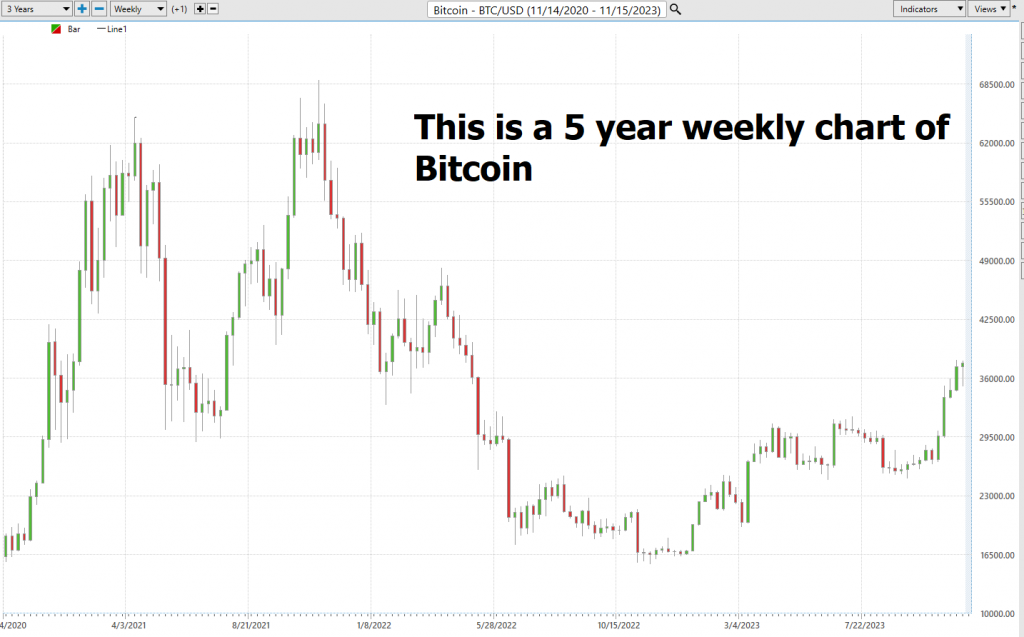
Now, this strategy has been a trusted companion for traditional stock investors, but its principles are proving equally valuable for those wading into the thrilling waters of digital assets like Bitcoin. So, whether you’re a seasoned trader or just starting out, let’s dive into the world of DCA and why it’s becoming a cornerstone for crypto enthusiasts.
Dollar-Cost Averaging, at its core, means making regular, fixed investments over time instead of making large, unpredictable bets. Now, we all know that cryptocurrencies, especially the poster child Bitcoin, can be a wild ride, with prices soaring and plunging at dizzying speeds. But by applying DCA to the crypto world, we can tame some of that volatility and bring a structured approach to our investments.
Instead of playing the risky game of trying to predict short-term price movements – something even the most seasoned traders find challenging – you steadily accumulate Bitcoin, come rain or shine. This approach safeguards you from investing your entire sum at a market peak and helps smooth out your average purchase price over time.
Bitcoin, my friends, is the pioneer in the crypto universe. It’s captured the world’s attention with its limited supply and growing adoption. Yet, the crypto realm is renowned for its wild swings. So, where does DCA come in handy? Well, it shines particularly bright in times like these.
Imagine embarking on a DCA journey just before a significant event like the “halvening.” This event, which occurs approximately every four years, reduces the rate at which new Bitcoins are created. The impact on Bitcoin’s price can be substantial, but predicting the exact outcome is akin to trying to catch lightning in a bottle.
By sticking to a DCA plan, you insulate yourself from the perils of buying at market peaks, ensuring you don’t miss out on potential gains. If the market aligns with your expectations, you can ramp up your investments. And even if it takes a downturn, your unwavering commitment remains intact.
Let’s take a moment to appreciate why DCA is winning hearts in the crypto world:
1. Automation: DCA allows you to automate your investments, making it not just convenient but also low maintenance. Platforms offer recurring orders sans additional fees, making it accessible to everyone.
2. Risk Mitigation: Spreading your investments over time minimizes the risk of buying at a market peak. DCA acts as a cushion against short-term price swings.
3. Simplicity and Peace of Mind: DCA is a long-term strategy that doesn’t demand constant monitoring or deep market analysis. It’s tailor-made for those who wish to grow their crypto assets without diving headfirst into the world of day trading.
Now, let’s be fair and look at the other side of the coin. DCA, while brilliant, might not be everyone’s cup of tea:
1. Modest Returns: DCA tends to yield stable, moderate returns, foregoing the allure of rapid gains. If you’re seeking to strike it rich overnight, you might explore other strategies.
2. Capital Deployment Delay: DCA means holding off on deploying all your capital at once, potentially missing out on early investment gains. This approach might not align with those seeking immediate returns.
3. Fee Consideration: When making smaller, regular purchases, fees could pile up, especially if your financial institution charges more for smaller transactions. It’s essential to factor these costs into your investment plan.
To embark on your DCA journey in Bitcoin, here are a couple of things to keep in mind:
1. Investment Frequency: Many platforms offer automatic purchases at various intervals – be it monthly, weekly, or even daily. Given crypto’s penchant for volatility, frequent purchases might make sense for Bitcoin.
2. Investment Amount: Remember, only invest what you can afford to lose. Analyze your monthly budget to determine how much discretionary income you have for investing and stick to that figure.
In a market as dynamic and volatile as cryptocurrency, dollar-cost averaging stands as a beacon of sanity and discipline. While it may not promise instant riches, it offers a systematic approach to growing your assets, especially in the world of Bitcoin, where long-term adoption and price volatility are intertwined.
So, whether you’re a seasoned investor or a novice looking to make wise financial choices, consider embracing dollar-cost averaging as a sensible strategy for your Bitcoin journey. In a landscape where uncertainty reigns supreme, this approach empowers you to navigate the crypto seas with confidence and resilience.
Simply observe the trajectory of the purchasing power of the US Dollar over the last 110 years. Does that look like it is going to reverse course anytime soon?
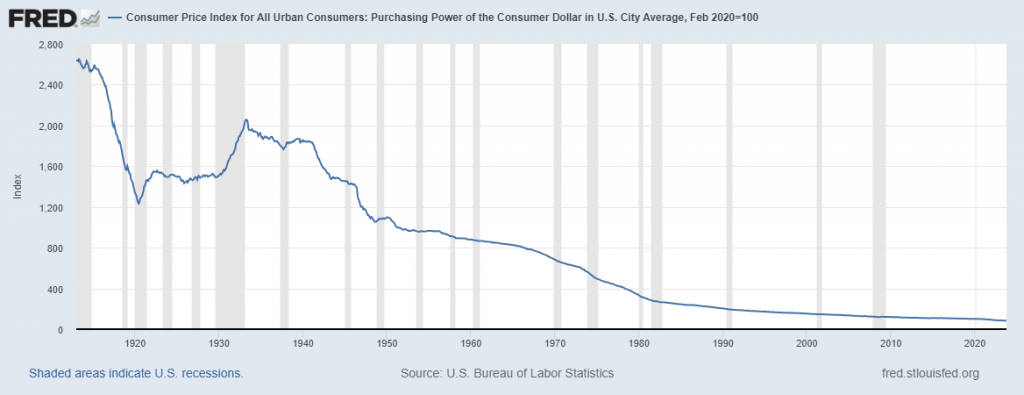
Here’s the bottom line. Regardless of what the headlines are telling you inflation is present and ravaging your savings and wealth. As money manager Ray Dalio states, “cash is trash.”
The challenge for wealth preservation is market selection. What assets are you using to store your wealth? Check out the listing below of some of the most popular assets and their corresponding performance over the past 1 year and 5-year time frames. Keep in mind that from these returns, you would also need to subtract the rate of inflation for each given time frame.
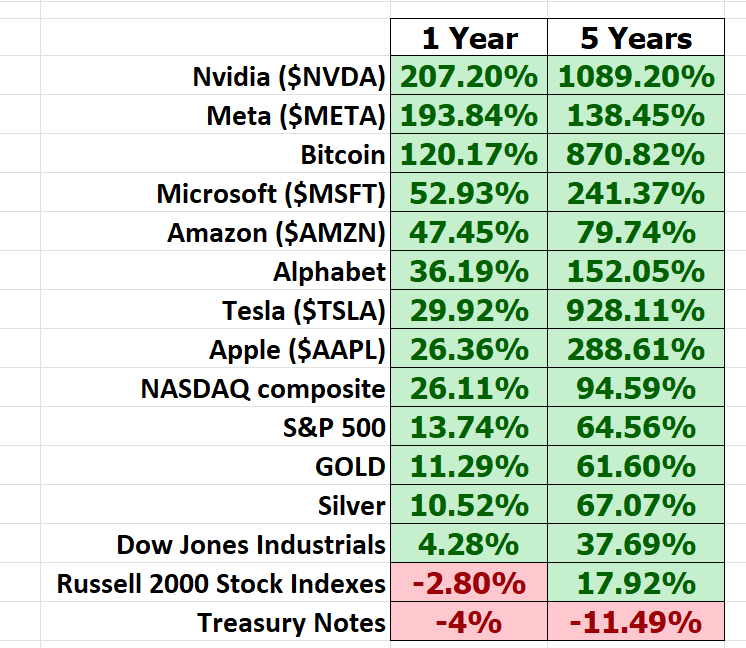
As I mention regularly on this blog, great traders focus on “what is winning?” You can clearly see that Bitcoin is holding its own even when compared to the top assets.
Might we experience another massive decline after a bitcoin ETF is approved? Possibly. But if you understand dollar cost averaging as I have explained in this article it will prove to be completely inconsequential.
Let’s delve into the top seven persuasive reasons why you should consider owning Bitcoin:
1. **Store of Value:** Bitcoin has often been referred to as “digital gold” for a reason. It shares key characteristics with gold, such as scarcity and durability. With a limited supply of 21 million coins, Bitcoin offers a hedge against inflation and economic uncertainties, making it a store of value akin to precious metals.
2. **Decentralization:** Bitcoin operates on a decentralized network, meaning it’s not controlled by any single government or entity. This autonomy shields it from political interference, censorship, or manipulation, giving you greater control over your own wealth.
3. **Financial Inclusion:** Bitcoin provides access to financial services for the unbanked and underbanked populations worldwide. With just an internet connection, anyone can participate in the global economy, sending and receiving funds securely and affordably.
4. **Security:** The underlying technology of Bitcoin, blockchain, offers robust security features. Transactions are cryptographically secured, making it extremely difficult for hackers to manipulate the network. Your Bitcoin holdings are also secured by private keys, which, if kept safe, ensure the protection of your assets.
5. **Portability:** Unlike physical assets like real estate or gold, Bitcoin is highly portable. You can store your wealth in a digital wallet accessible from anywhere in the world. This ease of transferability makes it a practical option for international transactions.
6. **Diversification:** Including Bitcoin in your investment portfolio can enhance diversification. Its low correlation with traditional assets like stocks and bonds means that it can function as a hedge against market volatility, potentially improving your overall risk-adjusted returns.
7. **Future Potential:** As adoption continues to grow, Bitcoin’s potential for value appreciation remains significant. Many believe that it’s still in its early stages, and as more institutions and individuals embrace it, its price may continue to rise.
Remember, while these reasons make a compelling case for Bitcoin ownership, it’s essential to conduct thorough research, consider your risk tolerance, and consult with a financial advisor before making any investment decisions. This article is not investment advice, it’s purely educational. As with any investment, there are risks involved, and it’s crucial to approach it with a well-informed and responsible mindset.
When we talk about the bottom line, we’re talking about what truly matters. It’s about making those tough decisions, the ones that might not always win you a popularity contest. For traders out there, it’s about survival, about beating that ever-persistent enemy called inflation, and staying competitive in a market that never stands still.
In this game, it all boils down to one thing – making more money by staying on the right side, of the right trend, at the right time. And let me tell you, that’s no easy feat in a world where dollars seem to be losing their value faster than a snowball in a heatwave. The Fed’s buying assets that no one else wants, and it’s driving up the prices of financial assets in the process.
Now, you’ve heard me share my opinion on the importance of dollar cost averaging, but here’s the deal – I never let my opinion interfere with my trading decisions. My reality is shaped by what I can see, hear, feel, and understand. But let’s be honest, that’s just a tiny part of the big picture. That’s why I turn to the powerhouses of artificial intelligence trading software, neural networks, and machine learning to guide my trading decisions.
Let me tell you, folks, we’ve all had our fair share of terrible trades. The winners in this game are the ones who learn the most powerful lessons from their losses. And that’s where artificial intelligence truly shines. It learns from what doesn’t work, remembers it, and then goes on to explore other avenues to find a solution. It’s a feedback loop that’s responsible for building the fortunes of every successful trader I know.
Now, think about this for a moment – A.I. applies mistake prevention to uncover what’s true and workable. It’s a continuous process, 24/7, 365 days a year, relentlessly searching for answers. That, my friends, is a game-changer.
So, don’t just sit around waiting and hoping for the Fed to make a move. Stay informed with the highest probability analysis brought to you by artificial intelligence.
And here’s the kicker – AI has outsmarted humans in poker, chess, Jeopardy, and Go! Do you really think trading is any different? It’s all about knowledge, useful knowledge, and applying it. That’s what AI delivers.
So why don’t you find out for yourself? Join us for a FREE Live Training session. We’ll reveal at least three stocks that AI has identified as poised for significant movement. And remember, any kind of movement in the market is an opportunity for profits!
Discover why artificial intelligence is the go-to solution for professional traders – it’s all about less risk, more rewards, and guaranteed peace of mind. Don’t miss this chance to step up your trading game!
Intrigued? Visit with us and check out the a.i. at our Next Free Live Training.
Discover why artificial intelligence is the solution professional traders go-to for less risk, more rewards, and guaranteed peace of mind.
It’s not magic. It’s machine learning.
Make it count.
THERE IS A SUBSTANTIAL RISK OF LOSS ASSOCIATED WITH TRADING. ONLY RISK CAPITAL SHOULD BE USED TO TRADE. TRADING STOCKS, FUTURES, OPTIONS, FOREX, AND ETFs IS NOT SUITABLE FOR EVERYONE.IMPORTANT NOTICE!
DISCLAIMER: STOCKS, FUTURES, OPTIONS, ETFs AND CURRENCY TRADING ALL HAVE LARGE POTENTIAL REWARDS, BUT THEY ALSO HAVE LARGE POTENTIAL RISK. YOU MUST BE AWARE OF THE RISKS AND BE WILLING TO ACCEPT THEM IN ORDER TO INVEST IN THESE MARKETS. DON’T TRADE WITH MONEY YOU CAN’T AFFORD TO LOSE. THIS ARTICLE AND WEBSITE IS NEITHER A SOLICITATION NOR AN OFFER TO BUY/SELL FUTURES, OPTIONS, STOCKS, OR CURRENCIES. NO REPRESENTATION IS BEING MADE THAT ANY ACCOUNT WILL OR IS LIKELY TO ACHIEVE PROFITS OR LOSSES SIMILAR TO THOSE DISCUSSED ON THIS ARTICLE OR WEBSITE. THE PAST PERFORMANCE OF ANY TRADING SYSTEM OR METHODOLOGY IS NOT NECESSARILY INDICATIVE OF FUTURE RESULTS. CFTC RULE 4.41 – HYPOTHETICAL OR SIMULATED PERFORMANCE RESULTS HAVE CERTAIN LIMITATIONS. UNLIKE AN ACTUAL PERFORMANCE RECORD, SIMULATED RESULTS DO NOT REPRESENT ACTUAL TRADING. ALSO, SINCE THE TRADES HAVE NOT BEEN EXECUTED, THE RESULTS MAY HAVE UNDER-OR-OVER COMPENSATED FOR THE IMPACT, IF ANY, OF CERTAIN MARKET FACTORS, SUCH AS LACK OF LIQUIDITY. SIMULATED TRADING PROGRAMS IN GENERAL ARE ALSO SUBJECT TO THE FACT THAT THEY ARE DESIGNED WITH THE BENEFIT OF HINDSIGHT. NO REPRESENTATION IS BEING MADE THAT ANY ACCOUNT WILL OR IS LIKELY TO ACHIEVE PROFIT OR LOSSES SIMILAR TO THOSE SHOWN.







